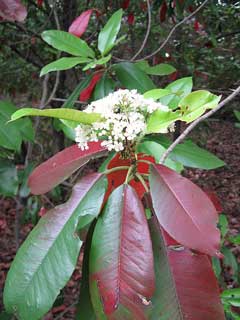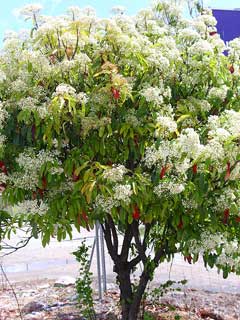 |
|
http://commons.wikimedia.org/wiki/User:KENPEI |
 |
|
Translate this page:
Summary
Bloom Color: White. Main Bloom Time: Early summer, Early spring, Late summer, Late spring, Mid summer, Mid spring. Form: Rounded, Vase.
Physical Characteristics

 Photinia serratifolia is an evergreen Shrub growing to 8 m (26ft 3in) at a medium rate.
Photinia serratifolia is an evergreen Shrub growing to 8 m (26ft 3in) at a medium rate.
See above for USDA hardiness. It is hardy to UK zone 7. It is in leaf all year, in flower in April, and the seeds ripen from September to October. The species is hermaphrodite (has both male and female organs) and is pollinated by Insects.
Suitable for: light (sandy), medium (loamy) and heavy (clay) soils and prefers well-drained soil. Suitable pH: mildly acid, neutral and basic (mildly alkaline) soils and can grow in very alkaline soils.
It can grow in semi-shade (light woodland) or no shade. It prefers moist soil.
UK Hardiness Map
US Hardiness Map
Synonyms
P. serrulata. Lindl. Crataegus serratifolia.
Plant Habitats
Woodland Garden Sunny Edge; Dappled Shade;
Edible Uses
References More on Edible Uses
Medicinal Uses
Plants For A Future can not take any responsibility for any adverse effects from the use of plants. Always seek advice from a professional before using a plant medicinally.
Anodyne Aphrodisiac Diuretic Febrifuge Stimulant Tonic
The leaves are diuretic, febrifuge, stimulant and tonic[218]. A tincture of the wood is ingested as a tonic and anodyne[218]. The plant is said to have excessive aphrodisiac properties[218].
References More on Medicinal Uses
The Bookshop: Edible Plant Books
Our Latest books on Perennial Plants For Food Forests and Permaculture Gardens in paperback or digital formats.

Edible Tropical Plants
Food Forest Plants for Hotter Conditions: 250+ Plants For Tropical Food Forests & Permaculture Gardens.
More

Edible Temperate Plants
Plants for Your Food Forest: 500 Plants for Temperate Food Forests & Permaculture Gardens.
More

More Books
PFAF have eight books available in paperback and digital formats. Browse the shop for more information.
Shop Now
Other Uses
Wood
The wood is hard and heavy, suitable for making furniture and other small articles[266].
Special Uses
Scented Plants
References More on Other Uses
Cultivation details
Landscape Uses:Pest tolerant, Screen, Standard, Specimen, Street tree. Requires a well-drained fertile soil in a sheltered position in sun or light shade[1, 200]. Prefers a warm soil that is not too heavy or close[11]. Tolerates calcareous soils[11, 200]. Dislikes windy sites[11]. Plants are hardy to between -7 and -12°c[200]. Hardy at Kew Gardens in all but exceptionally cold winters, this species is at its best in the milder areas of the country where specimens up to 15 metres tall exist[11]. There are some named forms, selected for their ornamental value[200]. The flowers have a delicate scent[245]. Plants are susceptible to fireblight[200]. Plants in this genus are notably resistant to honey fungus[200]. Special Features:Attractive foliage, Not North American native, Blooms are very showy.
References Carbon Farming Information and Carbon Sequestration Information
Temperature Converter
Type a value in the Celsius field to convert the value to Fahrenheit:
Fahrenheit:
The PFAF Bookshop
Plants For A Future have a number of books available in paperback and digital form. Book titles include Edible Plants, Edible Perennials, Edible Trees,Edible Shrubs, Woodland Gardening, and Temperate Food Forest Plants. Our new book is Food Forest Plants For Hotter Conditions (Tropical and Sub-Tropical).
Shop Now
Plant Propagation
Seed - best sown in a cold frame as soon as it is ripe in the autumn. Stored seed will probably require stratification and should be sown as early in the year as possible[78]. Germination is usually good[78]. When they are large enough to handle, prick the seedlings out into individual pots and grow them on in the greenhouse for their first winter. Plant them out into their permanent positions in late spring or early summer, after the last expected frosts. Basal cuttings in a frame[200]. Harvest the shoots with plenty of underground stem when they are about 8 - 10cm above the ground. Pot them up into individual pots and keep them in light shade in a cold frame or greenhouse until they are rooting well. Plant them out in the summer. Cuttings of half-ripe wood, 7 - 10cm with a heel, July/August in a frame[11, 78]. They take about 2 months to root and should be overwintered in a greenhouse, planting out in late spring[78]. Fair to good percentage[78]. Cuttings of almost ripe side shoots, 7 - 12cm with a heel, October/November in a cold frame[78]. Lift the following autumn and plant in their permanent positions[78]. Layering in autumn. Partially sever the layer about 12 months later and lift in the following spring. High percentage[200].
Other Names
If available other names are mentioned here
Native Range
TEMPERATE ASIA: China (Anhui Sheng, Fujian Sheng, Gansu Sheng, Guangdong Sheng, Guangxi Zhuangzu Zizhiqu, Guizhou Sheng, Hebei Sheng, Henan Sheng, Hubei Sheng, Hunan Sheng, Jiangsu Sheng, Jiangxi Sheng, Shaanxi Sheng, Sichuan Sheng, Yunnan Sheng, Zhejiang Sheng), Japan, Taiwan TROPICAL ASIA: India (south), Indonesia, Philippines
Weed Potential
Right plant wrong place. We are currently updating this section.
Please note that a plant may be invasive in one area but may not in your area so it's worth checking.
Conservation Status
IUCN Red List of Threatened Plants Status :

Growth: S = slow M = medium F = fast. Soil: L = light (sandy) M = medium H = heavy (clay). pH: A = acid N = neutral B = basic (alkaline). Shade: F = full shade S = semi-shade N = no shade. Moisture: D = dry M = Moist We = wet Wa = water.
Now available:
Food Forest Plants for Mediterranean Conditions
350+ Perennial Plants For Mediterranean and Drier Food Forests and Permaculture Gardens.
[Paperback and eBook]
This is the third in Plants For A Future's series of plant guides for food forests tailored to
specific climate zones. Following volumes on temperate and tropical ecosystems, this book focuses
on species suited to Mediterranean conditions—regions with hot, dry summers and cool, wet winters,
often facing the added challenge of climate change.
Read More
Expert comment
Author
(Desf.)Kalkman.
Botanical References
11200266
Links / References
For a list of references used on this page please go here
Readers comment
| Add a comment |
|
If you have important information about this plant that may help other users please add a comment or link below. Only comments or links that are felt to be directly relevant to a plant will be included. If you think a comment/link or information contained on this page is inaccurate or misleading we would welcome your feedback at [email protected]. If you have questions about a plant please use the Forum on this website as we do not have the resources to answer questions ourselves.
* Please note: the comments by website users are not necessarily those held by PFAF and may give misleading or inaccurate information.
To leave a comment please Register or login here All comments need to be approved so will not appear immediately.
|
Subject : Photinia serratifolia
|
|
|
|